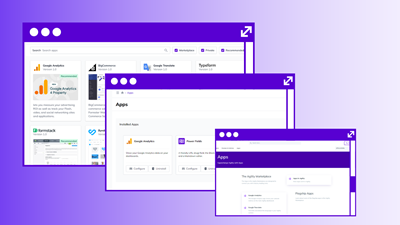Unlocking the Power of Content Architecture and Composability


Adapting quickly to changing market dynamics, delivering personalized experiences, and driving innovation have become paramount to remaining competitive. To manage these demands, successful organizations are leveraging the powerful combination of content architecture and composability.
Content architecture and composability are two complementary concepts that, when implemented effectively, provide a solid foundation for building scalable, modular, and future-proof systems. Content architecture involves strategically organizing and structuring content to optimize accessibility, reusability, and interoperability.
Composability, on the other hand, refers to the ability to assemble various components and services flexibly and modularly, allowing organizations to quickly adapt and respond to changing business needs.
Unleashing the Power of Composability: Unlocking the Benefits
Composability refers to bringing different systems together, enabling organizations to create flexible and modular designs that adapt to changing needs over time and comes with the benefits of:
Benefit 1: Unparalleled Flexibility
One of the primary advantages of composability lies in its ability to offer flexibility. Organizations can swap out individual elements by properly integrating diverse components without disrupting the entire system. The modular design allows for seamless component substitution, whether replacing a search engine, an e-commerce platform, or a personalization engine. This inherent flexibility empowers businesses to evolve and adapt quickly, facilitating continuous improvement without impeding existing operations. With composability, long-term flexibility becomes a cornerstone of system evolution.
Benefit 2: Accelerated Time to Market
Organizations can initiate development with a focused approach through composability by breaking down complex systems into smaller, manageable components. Rather than attempting to figure out all the intricate details and dependencies upfront, teams can begin by launching a small part of the system.
This iterative approach allows them to assess market viability, gather feedback, and make necessary adjustments before expanding and adding additional components. By incrementally building upon a solid foundation, businesses can witness tangible benefits at an earlier stage, reducing time wasted on thorough planning and boosting overall efficiency.
Benefit 3: Reduced Development Costs
Composable systems are often more cost-effective during the development process. The initial complexity is significantly reduced by starting the migration with smaller, more manageable components. This simplified approach enables developers to work with modern tools specifically designed for a focused task.
With a narrower scope, teams can leverage specialized technologies, accelerating development and streamlining the learning curve. As a result, development costs are optimized, and resources can be allocated efficiently to address specific needs. Composability empowers organizations to embark on development journeys with a leaner and more targeted focus.
Benefit 4: Enhanced Agility
The fourth benefit of composability lies in the enhanced agility it provides. Instead of seeking a one-size-fits-all solution, organizations can curate their technology stack by selecting platforms that align with their unique requirements. This allows businesses to tailor their systems to fit their needs, whether in e-commerce, search functionality, or analytics.
By embracing composability, organizations can avoid the pitfalls of rigid, monolithic systems and adopt a more agile and adaptable approach. This alignment with business goals and processes ensures that the technology solutions deployed fully align with the organization's strategic objectives.

-
Phase 1: Planning & Ideation
- Traditional: Higher costs associated with creating individual assets and templates.
- Composability: Lower costs due to reusable content blocks and modular templates.
-
Phase 2: Content Creation
- Traditional: Higher costs due to custom content creation for each instance.
- Composability: Lower costs with reusable content elements and pre-designed modules.
-
Phase 3: Review & Editing
- Traditional: Higher costs due to manual adjustments for each piece of content.
- Composability: Lower costs through easy updates of modular components.
-
Phase 4: Deployment & Maintenance
- Traditional: Higher costs for managing disparate content items.
- Composability: Lower costs with centralized management of modular content.

The Power of Content Architecture: Amplifying the Benefits of Composability
In the previous chapters, we explored the advantages of composability and its impact on system design. Now, let's delve into another critical aspect of modern business operations—content architecture. This chapter focuses on the benefits of combining composability with robust content architecture to unlock the full potential of your organization.
Benefit 1: Enhanced Usability
One of the primary advantages of proper content architecture is its boost to usability. After all, what good is a platform if it hinders rather than facilitates productivity? By adopting a thoughtful content architecture approach, organizations can prioritize the needs of their users. This entails understanding how users interact with the system, identifying their use cases, and optimizing workflows accordingly.
When content architecture aligns seamlessly with user requirements, it ensures a smooth and intuitive experience, allowing users to perform their tasks efficiently. Usability becomes a critical factor in delivering value through the deployed solutions.
Benefit 2: Rapid Content Updates
In today's fast-paced world, the ability to update content quickly is paramount. Organizations that lag in this aspect risk falling behind their competitors. Robust content architecture empowers businesses to stay agile and responsive by enabling swift content updates. By embracing composability in content management, organizations can easily integrate new pieces of content and leverage the growing number of integrations available.
With the right content architecture, businesses can keep their content fresh, up-to-date, and aligned with evolving market demands.
Benefit 3: Increased Productivity
Content creators and editors thrive in an environment that promotes productivity. A well-designed content architecture provides efficient tooling, streamlined processes, and a user-friendly experience. When content professionals can access powerful and intuitive tools, they can focus on their core tasks and deliver high-quality work. By investing in content architecture that prioritizes usability and productivity, organizations can create an environment that fosters employee satisfaction and retention. Employees are more likely to stay engaged and perform their best when they have the right tools.
Benefit 4: Scalability and Future-Proofing
As businesses evolve, change becomes inevitable. Organizations need a flexible and future-proof content architecture to adapt to shifting requirements without disrupting day-to-day operations. Composability and content architecture provide the necessary scalability to accommodate future changes. A robust content architecture ensures a smooth transition, whether introducing new functionalities, swapping out components, or aligning with revised business goals. By future-proofing content architecture, businesses can effectively navigate changing landscapes and stay ahead of the curve.
Benefit 5: Reduced Stress and Increased Adaptability
The pace of change in today's business world can be overwhelming. Flexibility in content architecture alleviates stress by providing a framework that allows for easy adjustments. With a well-designed system, businesses can seamlessly adapt to evolving requirements, preventing frustration and unnecessary obstacles. Content architecture that prioritizes flexibility ensures that organizations can meet new challenges head-on without compromising efficiency or getting locked into rigid processes. It empowers businesses to embrace change, adapt swiftly, and thrive in an ever-changing landscape.
The Combination of Content Architecture and Composability
By combining the benefits of composability with a robust content architecture, organizations can unleash the full potential of their digital ecosystem. Enhanced usability, rapid content updates, increased productivity, scalability, and reduced stress contribute to a dynamic and future-proof business environment. By harnessing these powerful principles, you can unlock the transformative potential of your digital landscape and stay ahead in an increasingly competitive business world.
The Perils of Poor Content Architecture
While the benefits of effective content architecture are evident, it is crucial to understand the risks and pitfalls associated with poor content architecture. This chapter will explore the dangers of bad content architecture and its impact on a composable solution.
Here's an example:

Wasted Time and Resources:
- Content Searching and Repurposing: $20,000 annually
- Duplicated Efforts: $15,000 annually
- Delayed Projects: $30,000 in project delays
- Subtotal: $65,000
Higher Maintenance Costs:
- Manual Adjustments: $10,000 annually
- Regular Updates: $8,000 annually
- Subtotal: $18,000
Inconsistent Branding:
- Rebranding Costs: $25,000 (due to inconsistencies)
Slower Time-to-Market:
- Missed Launch Window: $40,000 (delayed product launch)
Employee Turnover and Burnout:
- Recruitment and Training: $50,000 per employee (due to dissatisfaction)
- Subtotal: $100,000 (for 2 employees)
Customer Dissatisfaction:
- Loss of Repeat Business: $15,000 (customer churn)
Missed Opportunities:
- Missed Revenue from New Channel: $60,000
Technical Debt:
- Additional Development for Fixes: $12,000 (accumulated debt)
Lack of Structured Content
Often, organizations rely solely on rich text formats, neglecting the importance of structuring content. This limitation hinders the ability to link content together and work with structured lists efficiently. Structured content makes it easier to maintain consistency, reuse content across channels, and adapt to evolving design requirements. The absence of structured content severely limits the potential for content reuse and flexibility within the system.
Glued Integrations and Dependencies
An essential aspect of composable solutions is the ability to integrate and swap out components seamlessly. However, bad content architecture often leads to tightly glued integrations. This dependency between different components creates a fragile system; when attempting to remove or replace one component, it can break down the entire system. The lack of abstraction and loose coupling prevents organizations from evolving their systems and limits their ability to respond to changing needs and technologies.
Limited Flexibility and Adaptability
Without the proper architectural foundation, organizations are locked into rigid structures and processes, hindering their ability to embrace change. In a fast-paced business environment, the inability to adapt quickly can lead to missed opportunities and increased costs. Flexibility and adaptability are essential for staying competitive and meeting evolving customer demands.
Dissatisfied Users and Editors
Systems heavily reliant on rich text formats frustrate users due to their limited functionality and inability to perform complex tasks. Content editors face challenges when trying to pull content into different channels or work with it more flexibly.
Ineffective Composability
Composability lies at the core of a composable solution. However, bad content architecture undermines the essence of composability itself. When integrations are tightly glued together, it raises questions about the true composability of the solution. With a well-designed architecture that enables seamless integration and component interchangeability, organizations can experience the true potential of composability. A poorly architected solution can be a hindrance rather than an enabler.
Don’t let Poor Content Architecture Hinder your Goals
Understanding the risks of bad content architecture is crucial for building successful composable solutions. Organizations must be aware of and mitigate the lack of structured content, glued integrations, limited flexibility, dissatisfied users, and ineffective composability. By prioritizing sound content architecture practices, organizations can avoid these risks and unlock the full potential of their composable systems. In the next chapter, we will delve into best practices and strategies for implementing an effective content architecture that maximizes the benefits of composability and drives long-term success.
Unleashing Flexibility and Accelerating Time to Market: Combining the Two Disciplines
Combining content architecture and composability brings forth many benefits, enabling organizations to achieve flexibility and accelerate their time to market.
Flexibility to Adapt and Evolve
Flexibility lies at the core of composable solutions. By combining content architecture and composability, organizations gain the power to swap in seamlessly and out systems, select platforms that best suit their business requirements, and adapt to changing market dynamics.
Faster Time to Market
By decoupling components and orchestrating them effectively, organizations can launch independent parts of the system without overly relying on interconnected dependencies. This modular approach allows for parallel development and incremental roll-out updates and features. With faster time to market, organizations can capture opportunities, iterate on their solutions, and generate results more quickly.
Cost Efficiency and Reduced Risk
The combination of content architecture and composability helps to mitigate costs and minimize risks associated with large-scale projects. Instead of embarking on monolithic endeavors, organizations can adopt an iterative approach, building smaller, more manageable components that align with their immediate needs. This iterative development reduces the financial burden and allows organizations to allocate resources more efficiently. Organizations can identify and address issues early by continuously testing and refining smaller modules, reducing the risk of costly rework or system-wide failures.
Aligned Platforms and Targeted Solutions
Through the strategic implementation of content architecture and composability, organizations can ensure that their platforms and systems are closely aligned with their specific needs. Organizations can focus on smaller projects and systems that cater to specific requirements rather than attempting to integrate all functionalities into a single, monolithic system.
Increased Results and User Satisfaction
When content architecture and composability are combined effectively, organizations experience increased results and enhanced user satisfaction. By rapidly iterating and deploying targeted solutions, organizations can gather feedback, make data-driven improvements, and deliver value to users more frequently. This iterative approach empowers organizations to align their solutions with evolving user needs, ensuring a seamless and engaging experience. As a result, organizations can achieve higher customer satisfaction, increased user adoption, and improved business outcomes.
Harnessing the Power of Composability and Content Architecture: How to
Combining composability and content architecture brings benefits that can transform how organizations create, manage, and deliver content.
Strategic Planning and Future-proofing
Starting with strategy and forward-thinking planning is crucial when embarking on a composable journey. By drawing out the architecture and considering integration points with other systems and platforms, organizations can effectively plan for future evolution and growth.
Knowing Your Stack
A critical aspect of leveraging the power of composability and content architecture is understanding your stack of platforms and systems. Organizations utilize various platforms, such as marketing automation, email campaigns, CRM, analytics, etc. Knowing the function and value of each platform enables organizations to create a modular system that can be easily modified or expanded. By understanding the roles and capabilities of each platform, organizations can effectively combine and integrate them to meet specific business needs. This knowledge of the stack allows for more informed decision-making and flexibility in system design.
Service and Platform Modularity
Composable solutions emphasize the independence and autonomy of services and platforms. A modular approach enables organizations to leverage the strengths of each platform while maintaining loose coupling and reducing potential points of failure. An orchestrator, often facilitated by the content management system (CMS), acts as the glue that brings together different platforms and services, enabling seamless communication and collaboration.
Empowering the Composable Strategy
Content architecture acts as a catalyst for the composable strategy, enabling the effective implementation and management of a composable solution. By strategically combining composability and content architecture, organizations can create a robust framework that empowers teams to collaborate, integrate systems seamlessly, and unlock the full potential of their platforms and services. The content management system acts as an orchestrator, facilitating the harmonious operation of various components and enabling the realization of a true composable strategy.
Bringing the Two Together
The convergence of composability and content architecture offers organizations a transformative approach to content management and system integration. Organizations can harness the full potential of their platforms and services by incorporating strategic planning, understanding the stack, embracing modularity, maintaining abstraction, and empowering the composable strategy. The benefits include enhanced agility, improved scalability, optimized content reuse, streamlined workflows, and future-proofed systems.
Unlocking Headless CMS for Content Architecture and Composability
As a headless content management system, Agility provides a robust foundation for implementing content architecture and driving organizational composability. Its flexible architecture, coupled with a comprehensive suite of features, empowers organizations to build scalable and future-proof systems that deliver exceptional digital experiences.
With Agility, organizations can easily define content models, establish information hierarchies, and structure content to promote reusability and interoperability. This approach ensures that content is organized and accessible, forming the backbone of a solid content architecture.
Composability is seamlessly facilitated within Agility through its API-first approach and extensive integrations. The platform's robust APIs enable organizations to assemble various components, services, and platforms, creating a truly modular ecosystem. By leveraging these APIs, organizations can orchestrate their systems, enabling seamless communication and integration between different platforms without the need for complex and brittle dependencies.
Furthermore, Agility offers a user-friendly interface that effortlessly empowers content editors and marketers to manage and publish content across multiple channels. The platform's intuitive content management capabilities and support for content localization, personalization, and digital asset management further enhance the composability and flexibility of an organization's digital ecosystem.
It is time to unlock the full potential of your digital ecosystem with Agility, the ultimate companion for combining content architecture and composability. Embrace agility, embrace innovation, and unleash your organization's potential in the digital age.

About the Author
Harmonie is the Senior Marketing Manager at Agility CMS



